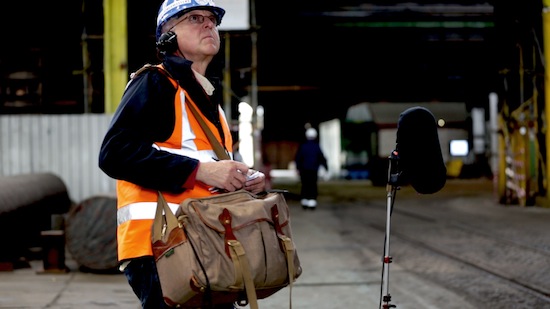Today, sound recordist Chris Watson will be presenting his sound map of Sheffield with two talks at the city’s Millennium Gallery. Inside The Circle Of Fire – a 36-minute-long collation of recordings by Watson, including submissions from members of the public, installed in the gallery on a 20-channel ambisonic speaker system and running until February 23 – is what Watson calls "a meandering walk" from Blacka Moor, the moorland on the edge of the Peak District, down to the Megatron, the hub of the labyrinthine network of flood protection tunnels that lies underneath the train station. Over its course, the piece sonically circumnavigates the city, weaving in the metallic clank of engineering firm Forgemasters, crowds singing at the Sheffield United and Wednesday football grounds and the daytime hum of Fargate, the city’s main shopping street. It frequently returns to the sounds of nature, those with which Watson is most familiarly associated, the birdsong that rings in the city’s parks and wooded patches and the flow of water, the recurrent theme in the piece, rendered spatially real by the speaker system.
The end result is hugely immersive and entrancing, a brilliant, frequently moving portrait of the city, aided by Alan Silvester’s wonderful series of black and white photographs of the places recorded, forming a comprehensive sum total of Sheffield’s audio texture. It also represents a return to his home city for Watson, who spent two years, on and off, recording the place where he first experimented with taping blue tits and robins feeding at the bird table in his back garden in Totley and formed industrial pioneers Cabaret Voltaire. This returning, as much to explore its contemporary sonic landscape as to revisit the locations of his earliest recordings, was what inspired Watson in his work of sound cartography.
Chris Watson: I’d been invited to do a piece of work for the gallery, this is over two years ago. I was born and brought up in Sheffield, but I haven’t lived there for 30 years. I was interested in this idea of mapping places in sound, and I thought this is my home city, I’d be really interested to go back there and listen and record and make a collaborative piece where people would make submissions as well. It grew on me, this idea that I’d like to revisit places that I remembered, but I didn’t want to do something that was nostalgic, I wanted it to be contemporary to 2013 and 2014.
I wanted to reinvestigate places as well, that I remembered, not to try and recreate, but to capture them as they were. So it sort of formulated itself, and Sheffield, it always seemed to me as I was growing up there, is geographically interesting, because it’s, like Rome, built on seven hills. There’s a moorland which sort of dominates the landscape out to the west, and I always remember this journey into town when we used to go to the studio, when I was with the band, there’s this progression down the valley. It came out of that, wanting to seek out places that I remembered and seek out other places, and go to Hillsborough and Bramall Lane, things like that, and rediscover that vibrancy that I remembered in Sheffield.
It sort of grew out of a period of months really. I’d recently done a piece in the Louvre in Paris – I work a lot with wildlife sounds, but I’d become interested in the built environment and what Sheffield had to offer, everything from industry to the great pedestrian areas – it was the first city, I remember, where we started to exclude traffic and hear things better in the city.
How did you set about drawing up the sound map and decide on which locations would be used for the recordings?
CW: First of all, I wanted to go back to where I started recording, which was effectively Blackamoor, where I used to walk out from Totley and record and became interested in what I was hearing. It also, geographically, gives you a really good overview of the city, and part of the work was to lead some sound walks, so last April, there was about 20 of us went up there and one of the first pieces I recorded was up on Blackamoor, about 2.30 in the morning. We all went up there to experience the sunrise over the city, but more importantly, the dawn chorus. That was a place that I remember, but also a very rich place to start, and then it’s very subjective: you could look down into the city from there and trace a route – I decided on the rivers. Sheffield’s a city of rivers: the Don and the Sheaf, the Rivelin and the Porter, the Loxley, they’ve shaped and sculpted the environment. Not only do they provide water for everybody there, but they’ve powered the city and the industry, so that seemed to me an obvious route in, to follow the water courses. Water which starts as rain on the hills, the high moorland, and then gathers and collects in Totley Brook and Knaresborough and places like that and then is channelled into the city, those rivers themselves have shaped the city and the geography. That’s why water runs, literally, throughout the piece: it starts with rain and ends with rivers being channelled underneath the city .
And then I picked places that I liked the sound of, so Shepherd Wheel, Forgemasters, part of the industry, the football grounds, which are a great source of sound, and rhythm and music, and then in between these little waterways. I discovered for myself these amazing areas where rivers like the Porter, the Sheaf and the Don just appeared in the middle of the city, in these little culverts in backstreets and I was fascinated to go back to those, they really were oases of sound. There was a lot of bird life and animal life along those sections, really in built-up parts of the city.
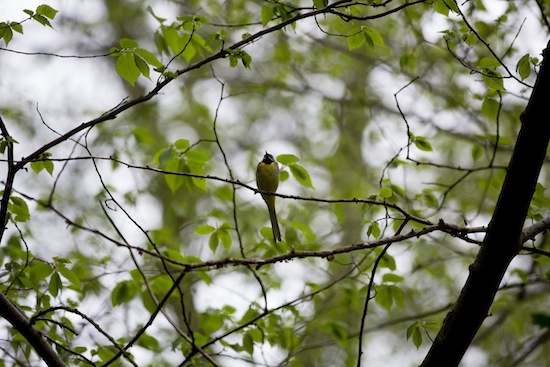
I went to a workshop at one of the few remaining little masters, one of the knife grinders and sharpeners. Something I was completely unaware of is that part of their process, these skilled craftsman, is a cold process: what you mustn’t do is heat the steel up because it loses its sharpness. So this guy had channelled through his workshop, the Pineapple Works right in town, a stream effectively, he’d got constant running water. So it seemed to me then to suggest itself, this theme of water.
And then I was keen to get people to contribute their sounds of the city, their signature sounds, so I was also guided by the remarkable series of contributions, well over 20, that people gave me to use in the piece. We did some sound walks, I did a couple of workshops that Museums Sheffield set up, where I talked about my work in this piece and also did basic practical location sound workshops, I went on Radio Sheffield and in the paper, and we had a website and put the call out for recordings. I think if you give people the opportunity, sound has that very personal feel to it, so people were really keen to suggest or contribute sounds that were familiar or interesting to them. What I said at the start was that anybody who takes the trouble to go out and record a piece, I guarantee that every piece that’s submitted will be used in the final work, which it is. It was great because everybody got credited – it’s not always obvious which bits are which but I really like that sense of collaborating.
What sounds did people send in?
CW: [laughs] It was an amazing selection! We did dawn chorus walks, one up in Blacka Moor and another in Ecclesall Woods, and they were oversubscribed, so most people came on those and did some recording at the same time as I did. I got quite a few of those, so those pieces are real collages. But then I got recordings of these weird automated traffic announcements in the pedestrian area, these robot, Dalek voices saying "stop", "two-way traffic", things like that, and then other bits and pieces in and around the city centre. And then one phenomenal piece, I have to say, that I just left entirely on its own, it’s right in the middle of the piece, that was from the Sheffield Buddhist Society, they sent me this beautiful recording of a Buddhist chant. Somebody did one with contact microphones on the fire escape at the back of the School of Architecture, this really musical, tuneful sound, then some other people put contact mics on the tramlines, so a lot of thought went into them.
Are the locations of the sound recordings geographically next to one another?
CW: Sort of. The idea was of waterways, but then there were diversions, because there are certain signature sounds of Sheffield that give it its character: Bramall Lane, Hillsborough, Fargate, the cathedral. Sheffield has, I think, more areas of woodland than any city, certainly in Britain, if not in Europe. So it has these wonderful pockets of wildlife sound, as well as the heavy industry which still remains, people like Forgemasters, of course I wanted to include that, some aspect of steel making. Museums Sheffield negotiated to get me into that, which was awesome, I spent half a day in there recording.
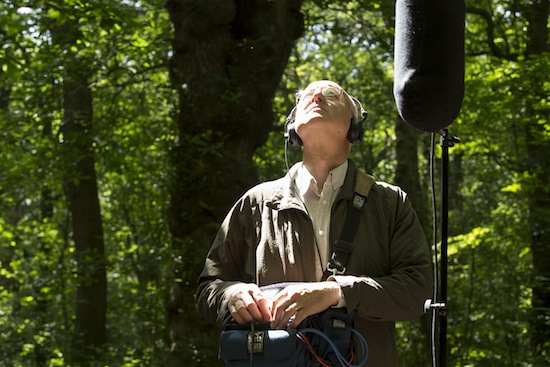
Regarding its composition, the piece had to flow; as well as following some sort of pattern, the pieces had to compliment each other. Of course it tends to mix and match between the woodland and industry, the people and places, things like that. It’s a meandering walk, if you like, it certainly starts on the hills, and it ends up in the very centre of the city, underneath the railway station, and in-between, it’s rather circuitous.
Did the project present any difficulties? Were there any sounds you particularly sought after?
CW: I was amazed to see how Sheffield had changed, it’s really in the process of transition and renewal at the moment. I was really keen to get the sound of something being flattened, knocked down, but I was a bit disappointed in that I naively thought that things were still done with giant wrecking balls and I was really excited by the prospect of recording that. I’d not done it, and as I said, I had become more and more interested, particularly with this project, in the sounds of the built environment. I know Museums Sheffield tried to find somewhere that was being knocked down in the recording period, but it just didn’t happen. The unfortunate thing is Castle Market has been demolished, but they weren’t doing it until after the piece had opened, otherwise I’d really liked to have done that, included the sounds of destruction.
One sound I was interested in was the Megatron – how did you record that? Was it easy to gain access?
CW: No it wasn’t. I didn’t even know it existed. I also put a call out for anybody who thought of really interesting sound-marks or sound-places to put me onto them, because, as I say, I haven’t lived in the city for 30 years. I got this quite cryptic message to say that there was this group of people investigating the rivers as they run into and under the city, and they’d found a place where they thought I might be interested to go and record. And I tried to find out more about it and I was just met with this wall of silence that said, "Look, if you’re interested, these people will get in touch with you and arrange a time and a place", and that’s exactly what happened. There’s a real movement in Sheffield where they investigate underground, under-city river systems, and these people had rediscovered the Megatron, which, again, I knew nothing about. But because Sheffield is the city of rivers, there is this whole network of tunnels, some that go back to the 19th century, under the city that channels rivers like the Porter and the Sheaf from the lower parts of the city to avoid flooding. There’s one in particular, this huge system, which ends in the Megatron, which starts near the Showroom cinema and actually the opening’s there, you can see it, and then it disappears underneath the railway station, comes out the other side, is exposed to a little bit to daylight and disappears again into the Megatron. So I was taken in one end with Alan Silvester, and we walked through and I recorded on route all the aspects, because it has these great cathedral-like acoustics. Particularly so underneath the station, where you’ve got all the railway lines above going down to London, literally thundering overhead with this huge rhythm of the rails, of goods trains and passenger trains, which I just found fascinated me. It came down through the tunnel network and echoed and reflected and reverberated down these tunnels, so it was a really powerful, dramatic piece.
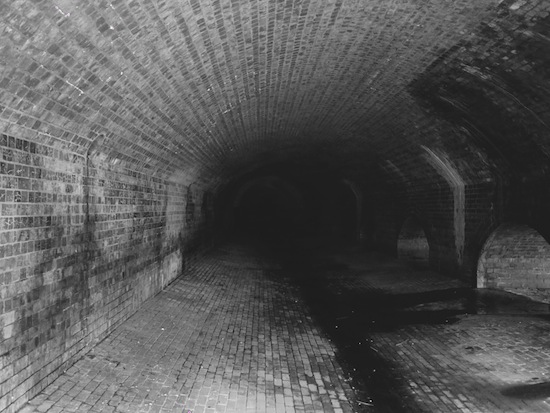
It seemed to me to suggest itself as a great place to conclude the work. I’d also been recording in places like Fargate and actually spontaneously one afternoon recorded a busker near Barker’s Pool, who was playing acoustic guitar near this drain system. When I was down in the Megatron, I could see all the drainage systems around town, and I imagined, romantically, the sounds of Sheffield, Barker’s Pool, the pedestrian area, this guy’s music, coming down into the river system and entering into the Megatron along with all the water and the sounds of this rail link out to other cities. The whole end of the piece is the collage where I aim to reflect that, all these sounds of the city percolating down into this underground river system.
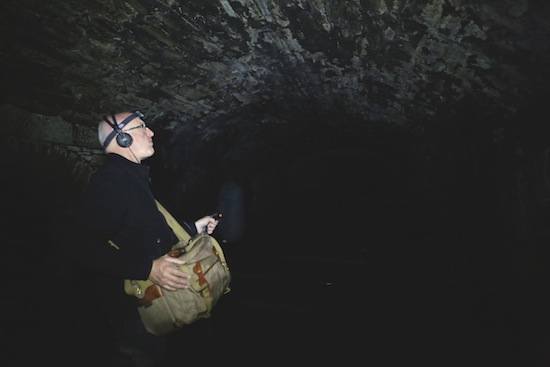
How did you decide on using photographs to accompany the piece?
CW: I don’t often use visuals in my work and I was concerned, putting a sound piece in a public gallery, what I was interested in doing, of course, was engaging people. I thought one way to do this was to use visual aspects, apart from the lighting, apart from the comfy seating, so Alan, this great photographer who works at the gallery, came out with me and documented lots of the recording trips I did, and then we put this series of images together which were black and white, so it’s not too distracting. I mean people can go in and close their eyes and just choose to listen, [but] I know some people like that sense of being able to engage with an image, so we used a series of non-synchronised images. What I didn’t want was to have a slideshow – everywhere you see is a place that you hear in the piece, but not necessarily at the same time.
Why did you call the exhibition Inside The Circle Of Fire? Do you see it as relating to your album Outside The Circle Of Fire?
CW: The back story to that is when I was in Venezuela, I found a book written by a French anthropologist about the Yanomami tribe of people that live in the Amazon rainforest. This anthropologist had discovered them and he got to live with them, and in fact ended up marrying one of them, and was fascinated by their culture, which is basically round the fire. That’s their known world, their universe if you like, so inside the circle of fire is their world, outside was the darkness of animals and wildness, and so they had that very simple division. He wrote a book, which is called Inside The Circle Of Fire, about the world of the Yanomami. So when I was working recording animals in wild places such as the Amazon and the Venezuelan rainforest, I reflected on that and tried to make a piece which reflected the other side, outside the circle of fire.
Then when I revisited Sheffield, we were stood on the moors last April, looking at the city at 3 in the morning, and it just glowed; it did appear as a circle of fire in the valley bottom, and I realised that’s where I’m from, that’s my home, that’s my circle of fire that I lived within. So I just plagiarised this guy’s title [laughs]! I felt like I was returning inside the circle of fire, because everything in the piece is inside the boundary of Sheffield, inside that circle of fire. It just seemed appropriate to me.
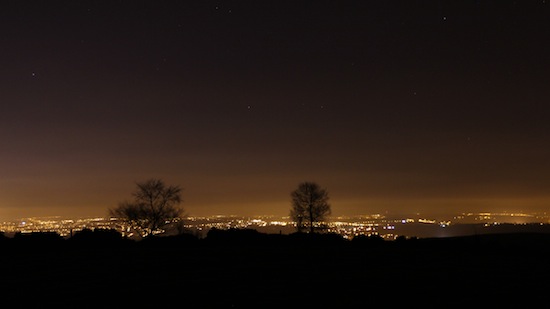
I wondered what you thought the overall effect of the sound map was? Would you describe it as a tribute to the city?
CW: I regard it first and foremost as a collaboration – I thought it was a real privilege and a pleasure to be invited by, first of all Museums Sheffield, and then for people, Sheffielders now, to be bothered to make a contribution. I’ve been really pleased by the way it’s been received, an incredible, positive response from the people of the city, more so than any other public work I’ve done. And so because I’m from Sheffield, I’ve been really proud to be associated with that. I’ve had comments, like one from a visually impaired person, who said it was the first time they’d been able to go into an art gallery and experience a work and get something really meaningful from it, and not only that, but it was their city, so can they could identify elements that they hear every day, elements that, unless you have an opportunity to listen to them, you would barely notice them. Like the one o’clock siren, in Barker’s Pool, I can’t remember ever hearing that, and then I had four individual contributions of it, so it’s obviously really a very significant sound-mark. And that’s exactly what I wanted to do, to provide a piece that reflects the sound of Sheffield now, in 2013/2014, a contemporary piece, and that’s the most satisfying thing, as well as being a collaboration.
Do you have your own signature sound of Sheffield?
CW: No I don’t really, I like the contrast between them. I like the dawn chorus in Ecclesall Woods, that’s a place I remember as a child, so that was important to me. Hillsborough, I used to go a lot, Bramall Lane, I’d go occasionally. They’re all really powerful and quite moving, some of them. Actually, the football crowds in particular, the number of people, particularly women, who have taken the trouble to get in touch with me to say I have no interest in football at all, but that it was really moving to hear that collection of voices. I’m just reminded constantly how powerful sound is in all our lives; sound really can move people, emotionally, psychologically and take you somewhere else.
Chris Watson presents lunchtime and evening talks at the Millennium Gallery in Sheffield today; head to the Museums Sheffield website for further details and tickets

